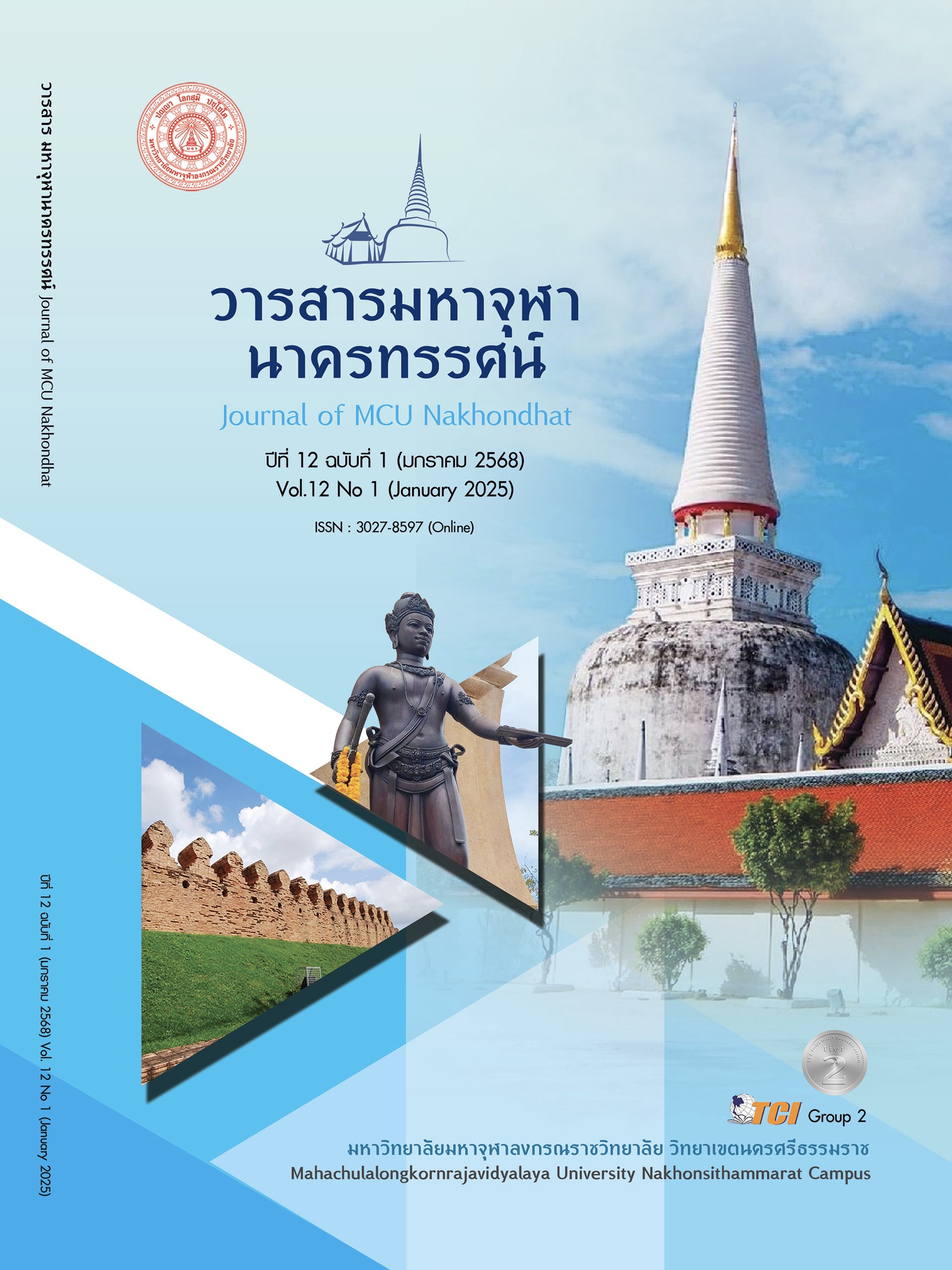FOLLOWING THE ASPIRATIONS OF BUDDHADASA BHIKKHU
Main Article Content
Abstract
This academic article aims to trace the approach of human resource development as conceptualized by Buddhadasa Bhikkhu, focusing on three main aspects: 1) Striving to grasp the essence of one's own religion, 2) Sostering interfaith understanding, and 3) Steering the world away from materialism. These aspects are applied to enhance the quality of life for youth in Surat Thani province through the formation of a youth network alliance, dedicated to uplifting lives based on the steadfast principles of Buddhadasa. The approach is contextualized into four key areas within Surat Thani: 1) Health and Physical Well-being: Emphasis is placed on ensuring that youth maintain good health, forming a foundation for spiritual practice. 2) Social and Economic Aspects: Youth are encouraged to build strong social relationships and stable family economics. 3) Mental Well-being: The focus here is on cultivating wisdom and mindfulness, enabling youth to navigate the complexities of the modern world. 4) Environmental Awareness: Youth are taught to live in harmony with their environment, fostering mutual support and coexistence. These guiding principles are aligned with Buddhadasa Bhikkhu’s vision and can be encapsulated into five core paths: 1) Buddhadasa’s Way: This path emphasizes understanding the nature of the mind and practicing Dharma to reach truth and freedom from suffering. 2) Proper Dharma Study: Encouraging a correct understanding of humanity, the threefold aspiration, and the reality of life’s evolution while nurturing mental development. 3) Natural Living: Advocating for unity with nature. 4) Dharma Study and Teaching: This involves deep understanding and application of the Buddha's teachings in a clear, tangible manner. 5) Dharma Presentation: Advocating for simplicity and accessibility in presenting Dharma teachings, focusing on effective and accurate understanding.
Article Details

This work is licensed under a Creative Commons Attribution-NonCommercial-NoDerivatives 4.0 International License.
References
เกียรติศักดิ์ ดวงจันทร์. (2562). แนวคิดของพุทธทาสภิกขุกับการออกมาจากวัตถุนิยม. วารสารนิติศาสตร์และสังคมท้องถิ่น, 3(2), 171-194.
นคร จันทราช และคณะ. (2563). พุทธทาสภิกขุ: ปณิธานข้อที่ 2 การทำความเข้าใจระหว่างศาสนา เพื่อเสริมสร้างสันติสุขในสังคมไทย. วารสารสันติศึกษาปริทรรศน์, 8(5), 2029-2040.
ปัทวี สัตยวงศ์ทิพย์. (2558). การแก้ปัญหาวัยรุ่นไทยในทัศนะของท่านพุทธทาสภิกขุ. วารสารวิชาการมนุษยศาสตร์และสังคมศาสตร์, 23(43), 85-104.
พระสมพงษ์ รติโก และคณะ. (2567). การวิเคราะห์เชิงอภิปรัชญาในงานนิพนธ์ของพุทธทาสภิกขุ. วารสารเสฏฐวิทย์ปริทัศน์, 4(3), 567-576.
ยุทธนา เพียรเวช. (2548). พุทธทาสสอนอะไร? ทำไม? อย่างไร? กรุงเทพมหานคร: สุขภาพใจ.
ละเอียด ศิลาน้อย และธานินท์ เหมบุตร. (2521). วิถีพุทธทาส วิถีสวนโมกข์. กรุงเทพมหานคร: ดอกหญ้า.
สมเจตน์ ผิวทองงาม. (2557). พุทธทาสภิกขุกับการแนะแนวทางการดำเนินชีวิต. วารสารมนุษยศาสตร์และสังคมศาสตร์ มหาวิทยาลัยราชภัฏสุราษฎร์ธานี, 6(2), 175-208.
สุดธิณีย์ ทองจันทร์ และคณะ. (2566). สุขภาพองค์รวมตามหลักปรัชญาของเศรษฐกิจพอเพียง. วารสารพุทธมัคค์ ศูนย์วิจัยธรรมศึกษา สำนักเรียนวัดอาวุธวิกสิตาราม, 8(1), 1-11.
อัครา บุญทิพย์. (2548). กฤษณาสอนน้องคำฉันท์ฉบับกรุงธนบุรี. วารสารมนุษย์ศาสตร์ปริทรรศน์, 27(2), 7-15.
อินทุวรรณา เชยชื่นสกุล. (2551). การนําโลกออกมาเสียจากอำนาจวัตถุนิยมตามความคิดและการปฏิบัติของท่านอาจารย์พุทธทาส. วารสารมหาวิทยาลัยราชภัฏสุราษฎร์ธานี, 1(2), 11-29.


